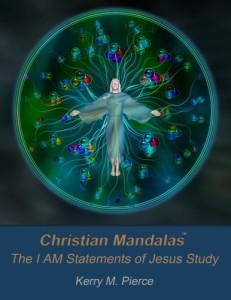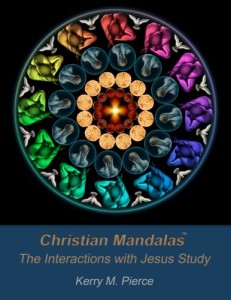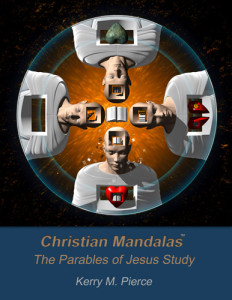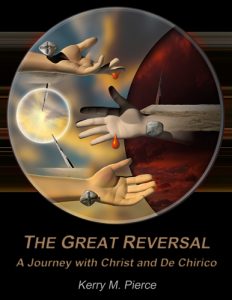Christian Mandalas† Small Group Curriculum:
The I AM Statements of Jesus:
What is the I AM Statements of Jesus Study? Jesus is recorded as using I AM statements. He used these statements in order to explain who he is. This study will center on the creation of Christian Mandalas for each of the I AM statements. There are seven important I AM statements in the Gospel of John made during Jesus’ earthy ministry: I am the bread of life; I am the light of the world; I am the door of the sheep; I am the good shepherd I am the resurrection, and the life; I am the way, the truth, and the life; and I am the true vine.
After Jesus’ resurrection we are given two more important I AM statements in the Book of Revelation: I am the Alpha and Omega and I am the root and the offspring of David, the bright morning star.
The final I AM Scripture was posed as a question to the disciples, and recorded in the three Synoptic Gospels: Who do you say that I am?
The Christian Mandalas in this study will give the individual profound insight into who Jesus is.
–
–
–
–
Click here to buy at Amazon.com
–
The Interactions with Jesus Study
From the Baptism of Jesus to his Ascension, we find a series of interactions between Jesus and his disciples. These interactions often take place during pivotal events such as the calling of the disciples, the Transfiguration, the Last Supper, and the post-Resurrection appearances. Through the exchanges in this study we see Jesus calling and making disciples to shape the Church and engage the world. In the process, we observe the 12 disciples understanding of who Jesus is grow. Their reactions and flashes of insight are often dramatic. The Scriptures in this study work beautifully in the mandala study format. By creating mandalas for these interactions you visually and emotionally place yourself into the realities the disciples were experiencing. The visuals you create will give you new insight into the events and new understanding. Finally, the study gives us an opportunity to reflect on our role as disciples and the ministries we are called to.
–
–
–
–
–
–
–
The Psalms Study

The Psalms Study Visual artists often strive to capture human emotion. A quick look through the works of the European Renaissance or the Baroque period reveal facial expressions full of raw emotion. The works of Rembrandt, Leonardo, Rubens, and Caravaggio are full of vivid examples. Caravaggio’s The Taking of Christ is intense. Modern animators have words to help a character convey a message, but the words are backed up with mouth, eyelid, and eyebrow positions that reinforce the mood. Human expressions are commonly grouped into six categories: sadness, anger, joy, fear, disgust, and surprise. Of course, the range of facial expressions is limitless, but these categories are very distinct, and easy to recognize. These expressions convey emotion. When reading the Psalms, one immediately picks up on the raw emotions found there. The emotions associated with the six facial expression categories can be found within the Book of Psalms. Many Psalms, such as Psalm 5 and Psalm 89, convey multiple emotions within the text. The reason why so many emotions can be found within the Book of Psalms is because the Psalms were written at different points during Israel’s history. So one could encounter Psalms from the time of the monarchy, to after the Temple in Jerusalem was destroyed around 586 BC. Because of this, the Psalms deal with anything from praise and thanksgiving to bitterness and lament. The Psalms provide a window into how the Israelites interacted with God, both as individuals and as a nation. The Psalms in this study work beautifully in the mandala study format, because of the Psalms’ strong emotions and poetic imagery. The mandalas you create will give you new insight into the poetic expressions of the Psalms, and provide a way to reflect on your own interactions with God.
–
–
The Parables of Jesus Study
Perhaps one third of Jesus’ teaching recorded in the Gospels is in the form of parables. Matthew and Luke are especially saturated with parables.
The Parables of Jesus are brief, engaging stories spoken by our Lord. They are excellent. For me, they are riddles to be dug into. They require a bit of effort and reflection, but there is treasure to be found.
The Parables of Jesus Study explores ten of Jesus’ parable teachings. They are as relevant today as when he first spoke them.
Though not a requirement, the Parables of Jesus Study works best for individuals who have already completed one of the other Christian Mandala studies.
–
–
–
–
–
–
The Great Reversal Study
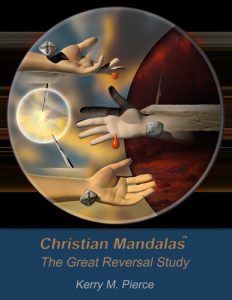 In the Gospel of Luke we find a recurrent theme which theologians refer to as the great reversal. These are unexpected, almost shocking statements from Jesus that cause us to stop and re-think our value systems. Sayings like: “Love your enemies”, “whoever would save his life will lose it, but whoever loses his life for my sake will save it”, “some are last who will be first, and some are first who will be last”, “It is more blessed to give than to receive”, and “For everyone who exalts himself will be humbled, but the one who humbles himself will be exalted”.
In the Gospel of Luke we find a recurrent theme which theologians refer to as the great reversal. These are unexpected, almost shocking statements from Jesus that cause us to stop and re-think our value systems. Sayings like: “Love your enemies”, “whoever would save his life will lose it, but whoever loses his life for my sake will save it”, “some are last who will be first, and some are first who will be last”, “It is more blessed to give than to receive”, and “For everyone who exalts himself will be humbled, but the one who humbles himself will be exalted”.
These great reversal sayings challenge us. “Love your enemies.” That is not easy. Reflecting on these great reversal sayings is often humbling. But God reminds us that he honors the humble, that the humble will be exalted.
In the great reversal study we find that the value system of the Kingdom is much different than that of our culture. The great reversal challenges us to focus on the Kingdom, rather than the world. We are called to use our energy, our love, and our gifts for the Kingdom.
The great reversal sayings, when reflected upon and applied to our lives, cause our focus to shift from our needs to the needs of others. Creating mandalas for these teachings will deepen your understanding of the great reversal and help you apply Jesus’ teaching to your life.
–
–
–
–
The Beatitudes Study
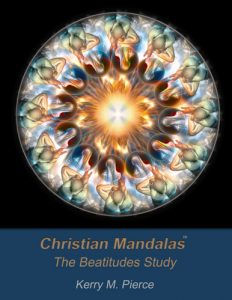
Jesus’ teaching and healing have begun to attract attention. As a result, large crowds began to follow him wherever he went. Matthew 5 begins, “Seeing the crowds, he went up on the mountain, and when he sat down, his disciples came to him. 2And he opened his mouth and taught them…”
Jesus wants to teach his disciples intimately. That he sat down and “opened his mouth” tells us that this is formal instruction on important content.
The first two blessings are surprising. “Blessed are the poor in spirit.” “Blessed are those who mourn.” Huh? Our first reaction may be that we do not want to be blessed if being poor in spirit and mourning are the conditions. Later blessings provide little relief, “Blessed are those who are persecuted for righteousness’ sake.” This message is the opposite of the world’s message. Blessed are those who are beautiful and spend money at exquisite venues, consuming goods and services with other beautiful people. “Blessed are the meek, for they shall inherit the earth.” What? Again, we are challenged. Isn’t it the proud, the powerful, the aggressive, and successful that accumulate the largest amounts of what the world has to offer? What does it mean to be meek?
Jesus moves our minds away from thoughts of an easy, prosperous life lived out by aligning with the world’s standards.
The Beatitudes have the perspective of the Kingdom of Heaven. The Kingdom is the unifying theme in Jesus’ discourse. In effect, the Beatitudes are guidelines for believers living in the Kingdom, as well as God’s blessings and favor towards those who aspire to live under his rule. Tidings of comfort and joy.
After the last Beatitude, Jesus states, “You are the light of the world.” What a compliment. Jesus says the same thing about himself in John 8:12, “I am the light of the world.” The Beatitudes enable us to become like Christ by teaching us Kingdom living.
Jesus’ Beatitudes are for believers, now. The blessings have started and will be fully consummated in heaven.
Level: Intermediate
–
–
Fine Art Books:
Surreal Christianity—A Journey with Jesus, Jung and Dali
Surreal Christianity explores techniques found in Surrealistic art and goes on to show how Christians can use those techniques to approach Scripture in new ways. Ways which enable the individual to more fully love God with all their mind.
In this exploration, there are over 70 color images from artists, including: Bosch, da Vinci, Tissot, Chirico, Picasso, Dali, Pierce, and others. Centering on three passages of Scripture: Psalm 1:1-2, Matthew 22:26-28, and Romans 12:2, we learn how God intends for us to use our minds.
On this journey, you may also develop a deeper appreciation for surreal art and some of the Christians who were, and are, a part of the Surrealist movement.
–
–
–
–
–
–
Jesus, Escher, and the Art of Christian Morphing
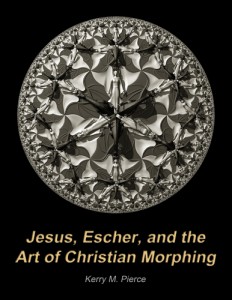 Jesus, Escher, and the Art of Christian Morphing explores the unique characteristics of the Dutch Artist M. C. Escher. The study explains how Christians can incorporate Escher’s qualities into their own interactions with Scripture. Interactions that enable the individual to morph towards Christ-likeness.
Jesus, Escher, and the Art of Christian Morphing explores the unique characteristics of the Dutch Artist M. C. Escher. The study explains how Christians can incorporate Escher’s qualities into their own interactions with Scripture. Interactions that enable the individual to morph towards Christ-likeness.
This investigation focuses on the Biblical Artwork of M. C. Escher. Escher’s visual reflections on Christ, together with three passages of Scripture: Matthew 17:1-8, 2 Corinthians 3:18, and Romans 12:2 teach us how to move forward on our Christian journey.
In this exploration, you will discover the spiritual side of Escher. An aspect of Escher not previously examined, but clearly revealed in his art, his lectures, and his personal letters.
You will also discover new techniques for studying Scripture. These techniques incorporate rules for how the brain learns best. Rules which Jesus incorporated into his teachings.
–
–
–
Click here to buy at Amazon.com
–
The Great Reversal: A Journey with Christ and De Chirico
In the Gospel of Luke and the book of Acts, we find a recurrent theme which theologians refer to as the great reversal. These great reversals are unexpected, almost shocking statements from Jesus, and interactions with Jesus, that cause us to stop and re-think our value systems. Sayings like: “Love your enemies”, “For whoever would save his life will lose it, but whoever loses his life for my sake will save it”, “And behold, some are last who will be first, and some are first who will be last”, “It is more blessed to give than to receive”, and “For everyone who exalts himself will be humbled, but the one who humbles himself will be exalted”.
These great reversal sayings challenge us. “Love your enemies.” That is not easy. But, Christ calls us to active discipleship. He calls us to operate as salt and light in the world. Engaging in the great reversal teachings of Jesus enables us to become more Christ-like.
In the great reversal study, we find that the value system of the Kingdom is much different than that of our culture. The great reversal sayings challenge us to focus on the Kingdom, rather than the world; to focus on the spiritual, rather than the sensory.
From late 1909 to early 1919, the artist Giorgio de Chirico painted through his metaphysical period. This decade is a unique moment in art when an individual bursts forth with a new style of painting. Thought was translated to canvas that the world had not yet seen. De Chirico’s works from this period form one of the most curious and fascinating moments in art history.
De Chirico’s works from the metaphysical period are meaningful because, like Jesus’ great reversal sayings, they deal with two different realms. The images encourage us to focus beyond the sensory and move to the spiritual. As such, they provide a visual means of understanding the intent of Jesus’ great reversal sayings.
Put another way, de Chirico’s art likely provides the best possible illustrations for Jesus’ great reversal sayings found in the Gospel of Luke and the book of Acts.
Click here to buy at Amazon.com
–
† Christian Mandalas is a trademark of Kerry M. Pierce.

